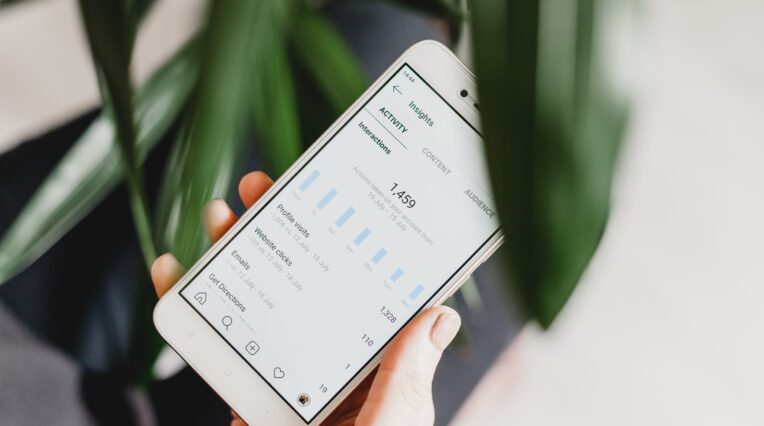20/04/2021
Maximising email ROI – The do’s, the don’ts and the how to’s

In this guide, we’ll cover:
- Growing your list
- Transactional and behaviour-based automations
- Personalisation and segmentation
- Customer retention
Introduction
If you haven’t seen the return that you’d like from your email marketing efforts, (in line with the current average ROI of 3800%), chances are you aren’t utilising developed functionality that’s available.
Today, the world of email marketing is undoubtedly more complex than ever. With ever-advancing functionality at our fingertips it can be overwhelming, meaning it’s not uncommon for brands to neglect some of the fundamentals such as segmentation, targeting and triggered automations, all of which are pivotal to channel growth.
We believe that, in order to grow your businesses and reach your business KPIs using email as a key channel, you have to first master the basics and then build out a robust and technically sound strategy. The aim? To increase revenue, nurture relationships and help to create a seamless, multi-channel experience for consumers.
In this guide, we’ll walk you through what we consider to be some of the key areas that can boost email ROI along with some quick wins and considerations for increasing engagement, giving you an effective, dynamic customer experience.
Growing you list
On-site data collection
Recent research has suggested that 96% of visitors to your website aren’t yet ready to buy or convert. So requesting a smaller commitment at this point, like asking them to sign up to your email list, gives you the chance to start a very important, valuable relationship.
One thing is for sure, first time visitors that are browsing your site are interested in your brand and what you have to offer. What you don’t want to do, however, is ruin your chances of encouraging them to sign up to your email list by jumping the gun and going in with a pop-up too soon.
Think about it: you’re trying to find out more about a pair of shoes and within fifteen seconds, you’re confronted with a subscriber pop-up – you haven’t had time to find the section you’re interested in yet, so you’re likely to click close and carry on looking for a pair of shoes you like.
Now try this: you’ve looked at three pairs of shoes on the site and have read about the shipping details, but you aren’t ready to buy yet as you want to think about which you prefer. After you’ve been browsing for a while, you get a subscriber pop-up and, as you liked what you’ve seen so far, you sign up to get 10% off your first order. This is the perfect time to have interacted with a new visitor as, at this point, they are more engaged and more receptive to being asked for an email subscription.
To find the optimum time to interact with a subscriber pop-up, use browsing data to work out what an average session looks like (average session time, pages per session, exit rate etc.). This will help you to build up a picture of how first-time visitors are interacting with your site and provide you with vital insights to help grow your list rapidly.
The key do’s and don’ts
- Don’t show a pop-up within the first minute of a first-time session.
- Do use first-time browsing session data to work out the optimum time to employ your subscriber pop-up.
- Don’t just collect email addresses; an effective, personal email strategy will depend on more data.
- Do consider using an incentive within your welcome series to help convert your new potential customers.
How to… grow your list
Increase opt-in boxes
Consider adding email opt-in boxes to your ‘make an account’ page, as well as allowing people to opt-in to emails when making a purchase or an enquiry. These are all points where customers or potential customers are highly engaged, so a timely opportunity to ask them to join your list.
These subscribers will be much more valuable than those who joined via a competition, so don’t neglect these opportunities. Just remember to make it clear for consumers when they sign up and provide a link to your privacy policy so that you’re GDPR compliant each time.
Be descriptive
Don’t just say “Sign up for our emails”. Telling people what they can expect will help to boost the amount of people that complete the sign up process. Go with something that clearly demonstrates the value for the subscriber, for example “Want to hear about new styles, sale previews and competitions? Sign up to our emails and be amongst the first.”
Find out about your subscribers
Ask them a little about themselves when they’re signing up, so you can make their emails more personal and relevant to them (and make it clear to them that’s why you’re asking). The GDPR means that marketers are now much more open about why they collect certain bits of data, which is a great way to build trust with consumers. We’d recommend collecting first names and interests so you can make sure they receive content and products that will resonate with them. You’ll find that your subscribers will welcome this approach, and it will also have a great impact on your results.
Transactional and behaviour-based automations
Automated emails that are based on a customer’s behaviour have eight times more opens and clicks than any other type of email and can generate six times more revenue, according to recent research from Experian.
Often, automated emails are transactional and help to keep the customer updated on their order status. ‘Trigger based’ automations are sent out because of something that a customer or prospect has done, for example abandoning their basket or a browsing session. Whereas once, automated emails were a nice addition to an email marketing strategy, they are now essential.
Depending on your business and sales process, we’d recommend devising a strategy that includes the following:
- Welcome email
- Abandonment email — based on orders, browsing sessions or wish lists
- Order, purchase or registration confirmation email
- Product recommendation email
- Review request email
If you’re a small team, these automated emails will help you to maximise email ROI whilst using minimal time and can actually help reduce the amount of customer service queries you receive. Once you’ve devised the strategy and set them up, you can leave them to run themselves, however, it’s vital to check in on performance to make sure you’re optimising them accordingly.
The key do’s and don’ts
- Don’t set up multiple automations and leave them to run without monitoring performance.
- Do regularly check in on engagement metrics and revenue, using these learnings to tailor communications.
- Do use as much behaviour data available as possible to help inform when emails are sent, what they should contain and frequency. There is no ‘one size fits all’ solution when it comes to varying customer and prospect audiences, so it’s best to use analytical data and historical metrics to inform your brand’s individual strategy.
How to… make your email automations work harder
Grow your automated programmes
Consider how many emails you’re sending per campaign. If you’ve currently got one welcome email going out to your audience when they sign up, can you build this out? We’d recommend a welcome series containing three to four emails, separating key USPs and vital information so each one makes more of an impact, and spreading your emails across a week or two.
Are your emails consistent?
When you’re working on numerous campaigns, it’s easy to let brand guidelines slip. Each email that you send out should look like it belongs to your brand and should all work in sequence with each other. If you’re sending transactional emails that don’t hold any resemblance to your welcome email or newsletters, you could confuse your customers and devalue your brand. Consistency really is key, and this applies across all of your marketing efforts. Your emails should share resemblance to your other marketing activity, so you’re delivering a seamless multi-channel customer experience.
Birthday automations
If you’re a retail brand, collecting a subscriber’s birthday when they sign up gives you an effective communication touch point for future campaigns. A ‘Happy Birthday’ email is not only personal and engaging, they hold significant ROI when compared with some other campaigns. We’d recommend a series of emails to go out during the month offering discount or a free gift when placing an order as an incentive. These campaigns also act as an excellent re-engagement opportunity.
If you’ve already got a substantial database, you could send out a dedicated campaign asking subscribers for their birthday. It shows you want to get to know them better, and subscribers are usually happy to provide details if they know there’s value in it for them.
Personalisation and segmentation
When it comes to email, personalisation and segmentation aren’t anything new. But it’s surprising how many people still aren’t utilising these relatively simple techniques. Of course, depending on your ESP, opportunities vary hugely — but most ESPs will allow the basics.
Personalisation
Using certain personal information within email copy or images will help make your messaging stand out and keep your messaging as personal as possible. Some of the most effective ways you can personalise emails can be done by using the following:
- Name
- Location (so you can insert place names/store names e.g. closest brickand- mortar store)
- Account manager or customer service representative
- Transactional information
Simply using a subscriber’s name within an email is the easiest form of personalisation and is simple to do. We’d always advise collecting a name at point of sign up so that you can use it for future emails, even if you’re not currently using any personalisation. Inserting a name into subject lines, pre-headers and even images and body text is a quick win when it comes to making your email directly relatable to the subscriber.
The key do’s and don’ts
- Don’t overuse personalisation to the point that it becomes slightly creepy or even spammy. There’s a balance to be had, so only use it when you feel it complements the campaign.
- Do use relevant customer service/account manager’s names where appropriate to help keep messaging consistent for your subscribers. For example, if Barry spoke to customer service rep John about an issue, inserting ‘John’ into a follow up email shows that you’re acknowledging previous conversations and appears much more personal than a blanket response.
How to… use personalisation to maximise engagement
First name personalisation
Using first names can really complement an initial welcome email, cutting through the noise of their busy inbox. Welcoming your new subscriber by name can be an effective addition to make your email appear much more targeted and personal, starting your relationship off as you mean to go on, a much more one-to-one approach.
Location based personalisation
If you’ve got hundreds of stores, collecting location-based information allows you to be more targeted and helpful if you’re sharing store information. For example, if you’re sending a campaign that promotes a new in-store offer, you can insert the name of your subscriber’s closest store. This instantly tells the recipient that the offer is running in their local store or informing them of the location of their closest store if they don’t already know.
Transactional data
Including transactional information within product recommendation emails can help to show how well you know and understand your customers. It can transform and personalise messaging such as “Here are some products you might like” to “Thanks for your purchase of the Blueberry handset in November, we thought you might be interested in our new product that can extend its battery life by 600%”. It’s a much softer way of cross promotion, shows that you know your customers well and gives you reasoning behind upselling.
Segmentation
Simply put, segmentation allows you to tailor your messaging more effectively, to a varied audience. Sending a blanket campaign to all isn’t necessarily wrong, but it will usually be reflected in your results. For example, if you’re sending an email to promote a romantic break to your entire list, you might be sending it to someone who has told you that they always travel alone or with a family, so simply won’t be interested. Instead, you’d want to use dynamic content (ESP functionality to tailor information within an email based on who you’re targeting) for each audience, which promotes a more relevant trip. You could have three bits of content, such as a romantic break, a solo break and a family break, and the user data would distinguish which content subscribers are shown. This really helps to increase relevancy, boosting campaign engagement and, of course, would maximise ROI.
In fact, Mailchimp have reported segmented campaigns receive 100% higher click-through rates when compared with non-segmented campaigns — need we say more?
Depending on your business and objectives, there are endless ways in which you can segment your email list, the most common being:
- Behavioural data (e.g. prospect v customer)
- Transactional data
- Gender
- Geographic location
- Interests
The key do’s and don’ts
- Don’t be too assumptive if you aren’t sure — there’s nothing worse than guessing wrong and potentially upsetting your subscribers or becoming even more irrelevant.
- Do use as much segmentation as possible. The more specific and relevant you can be, the better engagement you will receive and the stronger your subscriber relationships will be.
- Do dedicate time to work on your segmentation. Often, it’s overlooked and, when done properly, it really pays off.
How to… use segmentation to boost engagement and ROI
Discovery campaign
If you’re lacking segmentation options, run a specific campaign to find out more about your subscribers. Customers appreciate better targeting and relevancy, so are usually happy to share information to help brands get to know them better. Running these ‘discovery’ campaigns can also help reengage with dormant subscribers who may be uninterested due to being sent irrelevant products and might have stopped regularly engaging with your emails a while back.
Gender segmentation
For most brands, using gender segments is incredibly powerful. However, for some companies, it’s best to ask what people want to hear about rather than their gender. For example, some women might like to shop for a male friend or partner so you could be missing out by adding them to a ‘female only’ segment.
B2B segmentation
For many B2B companies, basic segmentation for customer v prospect should already be implemented. These very different audiences will benefit from tailored messaging, content and sending frequency. You might want to differentiate introductory offers with cross-selling and tailor messaging accordingly for each segment.
Dynamic content
Most ESPs offer dynamic content functionalities. Using custom fields in your database allows you to conditionally display content based on stored information.
For example, you might have a block within your email with an image detailing your subscriber’s closest store. Using dynamic content means that if a subscriber’s closest store is Stoke, they’ll be shown a map and opening times for the stoke store, whereas if it’s Bournemouth, they’ll see the Bournemouth store information. This can remove a few steps for the subscriber, who usually has to click an image that reads ‘Find your closest store’ and look it up on the website themselves.
Customer retention
Usually, we observe a lot of time spent acquiring new customers and, whilst new customers are important, retaining your existing customers is cheaper and can also deliver a much greater ROI.
When it comes to B2C, eTail recently reported that 80% of business professionals believe that email marketing increases customer retention, proving that email is key to an effective retention strategy. There are several types of campaigns on the menu, allowing you to target customers at different stages that all share the same aim — to inspire loyalty.
The main thing to bear in mind is that retention campaigns are specifically to increase customer value and fall separately to other regular communications, such as newsletters and regular promotional emails. As well as the obvious aim of encouraging repeat purchases, these campaigns are designed to cultivate a stronger, more positive relationship between brands and consumers.
Re-engagement campaigns
A re-engagement campaign is the perfect way to re-engage with customers who might not have purchased for a while. Old customers could be sat in your email list that might not have opened an email from you for some time. Sending a targeted, specific offer to encourage them to come back and purchase again can be exactly the type of message that will resonate with them. If you know the date of their last purchase, this could be how you segment previous customers, as someone who hasn’t purchased in a year should get different messaging from someone who hasn’t purchased in a month.
You could say “We miss you! We’ve noticed that you haven’t purchased in a while, so here’s 10% off your next order”. Some brands are really clever with their creative for re-engagement campaigns so, depending on your branding, be playful and, where possible, think outside the box from your usual campaign style. You want these to stand out enough to make old customers take notice and engage.
Nurturing campaigns
A good nurturing campaign should create brand ambassadors as well as keep customers purchasing more regularly. Spending time nurturing your customers is vital if you want to produce an engaged customer base that has longevity. Welcome emails essentially start off the nurturing process, with post-purchase being another key opportunity to use nurturing emails.
An important aspect of a solid customer nurturing campaign is acknowledgement. You could identify your most valuable customers and treat them differently from others within your list. Think of this segment as your ‘VIPs’. And when we say acknowledgement is key, we mean tell them that they are one of your most valued VIP customers. You could provide them with exclusive sale previews and invite them to exclusive events as part of being a VIP customer. This exclusivity will help build the relationship further, instilling a sense of ambassadorship and really cement brand loyalty.
Nurturing campaigns
A good nurturing campaign should create brand ambassadors as well as keep customers purchasing more regularly. Spending time nurturing your customers is vital if you want to produce an engaged customer base that has longevity. Welcome emails essentially start off the nurturing process, with post-purchase being another key opportunity to use nurturing emails.
An important aspect of a solid customer nurturing campaign is acknowledgement. You could identify your most valuable customers and treat them differently from others within your list. Think of this segment as your ‘VIPs’. And when we say acknowledgement is key, we mean tell them that they are one of your most valued VIP customers. You could provide them with exclusive sale previews and invite them to exclusive events as part of being a VIP customer. This exclusivity will help build the relationship further, instilling a sense of ambassadorship and really cement brand loyalty.
Follow-up campaigns
Follow-up campaigns are based on transactional and behavioural data. Depending on your business offering, there are numerous ways that you can utilise this approach within your email strategy. Commonly, brands implement product recommendation emails post-purchase, to encourage upselling based on purchase history. Some ESPs will automatically use data to suggest similar products when sending out recommended product emails, whilst others require a more manual process. Whatever process you take, these campaigns can be very valuable, providing you with an opportunity to showcase your product range or highlight complementing items and additional extras.
Alternatively, you could nurture a customer after their first purchase with more information-based emails. For example, you could share useful hints and tips on how to use a new product that they purchased. If they’ve purchased a service, you could send them a series of emails telling them more about what to expect and then have regular touch points throughout the coming months, sharing further information and offering support.
The key do’s and don’ts
- Do use personalisation to help these emails stand out from your usual newsletters.
- Do be more creative and use more character than your regular email campaigns, whilst staying true to your brand, to grab unreactive customer’s attention.
- Don’t neglect post-purchase touch points — they can be perfect for personalised, targeted emails that offer support or relevant products.
- Don’t bombard your customers with too much after they’ve purchased — think about your key business KPIs and work backwards on how best to achieve these, whilst still considering the overall customer experience.
- Do cross-promote other channels and customer support services, such as social media, to make your brand approachable.
How to… introduce customer retention into your email strategy
Re-engagement campaigns
Try running a re-engagement campaign every few months to customers that meet a certain criterion and run AB tests to find out what initiative works. Alternatively, you could set up an automated re-engagement campaign that will run after X days after a customer’s last purchase.
Post-purchase campaigns
Consider regular touch points throughout the customer journey, sharing insights and information that will help them once they’ve purchased from you. For example, if someone purchased a laptop from you, send them an email a week later checking how they are getting on with set-up. You could also send a few emails over the coming months with insider tips and how to make the most out of their new laptop. These types of communications help to promote your brand as customer-focused. Not only are you nurturing early relationships, customers are more likely to recommend you and are more likely to come back to you in future for repeat purchases.
Customer experience
Develop a post-purchase strategy that delivers a great customer experience as well as optimising potential upsell/cross-sell opportunities. Offer a balance of help and support (value for the customer) with recommended products (value for you).





